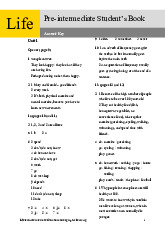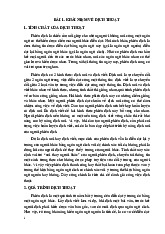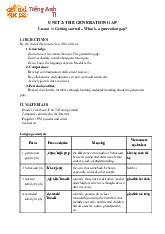





Preview text:
LESSON PLAN
TIẾNG ANH 11 FRIENDS GLOBAL UNIT 4: HOME
LESSON 4H – WRITING: AN EMAIL I. OBJECTIVES
By the end of this lesson, Ss will be able to: 1. Knowledge
- Know and understand vocabulary related to moving house and introducing preferences.
- Gain knowledge of appropriate language and phrases for informal emails and letters.
- Know how to use the "would rather" structure to express preferences. 2. Competences
- Understand and discuss the content of an email about moving house.
- Discuss their own preferences and experiences related to moving house.
- Write an email about moving house using appropriate language and structure.
- Develop their writing skills by effectively organizing ideas and expressing preferences in writing. 3. Personal qualities
- Develop effective communication skills.
- Show respect and consideration for others' preferences and experiences.
- Demonstrate creativity and critical thinking in expressing their own preferences in writing. II. MATERIALS
- Grade 11 textbook, Unit 4, Writing
- Computer connected to the Internet - Projector / TV/ mini boards - PowerPoint Unit 4H III. PROCEDURES
1. ACTIVITY 1: WARM-UP (7 mins) a. Objectives:
- Introduce the new lesson and set the scene for Ss to acquire new language.
- Engage students from the start of the class to capture their attention.
- Tap into students' prior knowledge.
- Foster students' confidence and enthusiasm for the lesson. b. Content:
- Dream Home Match-Up (Speaking Activity) - Exercise 1. (p.57) c. Products:
- Students write on index cards, discuss and report orally. d. Organisation
TEACHER’S AND STUDENTS’ ACTIVITIES CONTENT
Exercise 1 - Dream Home Match-Up (4 mins)
- T goes through the instruction on the slides. Different cities:
- T gives each pair 2 index cards. E.g.
- Ss first work in pairs of 4-5 and have 2 minutes to 1. Paris
decide on their cities and the relevant details. 2. Tokyo
- When they’re done, Ss start comparing their choice 3. New York
and looking for those with the same interest and then 4. Beijing form new groups. 6. Sydney
- The winner group is one that has the most members.
A short presentation by the winner group (3 mins)
- T asks the winner group to justify their choice in front
Which city would you like to live in?
of the class, talking about advantages in terms of Why?
culture, attractions, climate, lifestyle, or personal interests, etc.
- A few students volunteer to share their ideas with the class. e. Assessment
- Teacher observes the groups and give feedback.
2. ACTIVITY 2: PRE-WRITING (20 mins) a. Objectives:
- Ss can identify the tone conveyed in an email.
- Ss understand the use of “would rather” to talk about preferences.
- Ss know how to organize ideas and information effectively.
- Ss understand the Writing stategy.
- Ss gain some useful phrases to write an informal email or letter. b. Content: - Exercise 2 (p.57)
- Pre-teach some useful phrases. - Exercise 3 (p.57) - Exercise 4 (p.57) - Exercise 5 (p.57) - Exercise 6 (p.57) c. Products:
- Ss take notes of new phrases, discuss with their friends, complete exercises in their books. d. Organisation
TEACHER’S AND STUDENTS’ ACTIVITIES CONTENT
Exercise 2: Read the email. Do you think Ellie is happy or unhappy with her new home? Find
evidence in her email. (2 mins)
- T asks students to complete the task in pairs. Answer:
- T checks answers as a class.
I think Ellie is happy with her new home.
She talks about the advantages of the new
flat, such as being close to the shops and
making friends with her neighbour.
Exercise 3: Does the email cover all four points in the task? Match sentences in the email with each point. (3 mins)
- T goes through the instructions and elicits whether or Answer:
not the email covers all four points in the task.
The email covers all four points in the task. - T check answers as a class.
1 It’s brilliant being so close to the shops,
and the flat is bigger than our old one.
2 It’s quite noisy, though, as there is a lot of
traffic. I’d rather it were further from the main road.
3 I met one of our neighbours yesterday.
She’s about my age. 4 Also, would it be OK
if I used your bike for a few days?
Vocabulary teaching (3 mins)
- Teacher introduces the phrases.
- Ss underline them in the texts and match them with their uses.
- Teacher checks students’ understanding and conduct
oral drill chorally and individually.
- Ss take notes of the new vocab.
Exercise 4: Read the Writing Strategy. Then read Ellie’s email again and underline. Give examples (5 mins)
- T goes through the Writing Strategy, then asks Answers:
students to read the email again and answer the
1 I look forward to receiving your reply. questions.
More informal: Looking forward to hearing
- T goes through the slides to check answers as a class. from you! Write soon!
2 We’ve, It’s, I’d; She could have used:
Hope everything’s OK with you; There’s a
lot of traffic; Mine’s at the bike shop.
3 Got to go now. ‘I’ve’ has been omitted.
Exercise 5: Read the Learn this! box. Circle three examples of would rather in Ellie’s email. (4 mins)
- T goes through the Learn this! box. Make sure that Ss More examples:
understand the difference between would rather
(not) + infinitive without to and would rather + subject
I’d rather not go to the cinema. (I don’t + past simple.
want to go to the cinema.)
- Ss find examples of the structures in the email.
I’d rather you didn’t go to the cinema. (I
- T checks answers as a class.
don’t want you to go to the cinema.) Answers: Line 6.
I’d rather it was … further from the main road. Line 10.
I’d rather not go alone. … Line 12.
I’d rather cycle to school than get the bus.
Exercise 6: Read the task below. Make notes for each of the four points in the task. (3 mins)
- T asks students to read the task and in pairs make notes You have recently moved to a house in the for each of the points.
country. Write an email to a friend. Include
- T circulates and monitors, helping with ideas where the following: necessary.
• Describe the advantages of being in the country.
• Mention something you would change.
• Mention something that went wrong during the move.
• Ask if you can stay a night at your friend’s house. e. Assessment
- Teacher checks students’ pronunciation and gives feedback.
- Teacher checks students’ understanding of writing strategy.
- Teacher observes Ss’ writing of vocabulary on their notebooks.
- Teacher observes group work and gives feedback.
3. ACTIVITY 3: WHILE WRITING (15 mins) a. Objectives:
- Ss can list their preferences.
- Ss can write an email about a new home. b. Content: - Exercise 7. (p.57) - Exercise 8. (p.57) c. Products: - Students’ writings. d. Organisation
TEACHER’S AND STUDENTS’ ACTIVITIES CONTENT
Exercise 7: Complete the useful phrases for starting and ending a letter or email. Find two more in Ellie’s email. (5 mins)
- Ss complete the phrases and find two more examples in the email. - T check answers as a class.
Exercise 8. Write your email (150–180 words) using your notes from exercise 6 and phrases from exercise 7. (10 mins)
- Ss spend time writing their emails. Student’s performance
- T circulates the classroom to monitor, takes
notes of some significant mistakes and provide
help with language if necessary. e. Assessment
- Teacher observation on Ss’ performance.
4. ACTIVITY 4: POST-WRITING (5 mins) a. Objectives:
- Ss can improve their writing based on feedback. b. Content: - Check your work. c. Products:
- Students take notes of their mistakes and how to improve their writings d. Organisation
TEACHER’S AND STUDENTS’ ACTIVITIES CONTENT Check your work (5 mins)
- Ss exchange their writings in pairs to give feedback to Have you …
their friends’ writings.
• included all four points from the task?
- T gives feedback without saying who made the errors. • used appropriate language (see the
- T selects randomly some writings to assess and gives Writing Strategy)?
more detailed feedback in the next class.
• included appropriate phrases for starting and ending the email? e. Assessment
- Teacher observation on Ss’ performance.
- Teacher’s feedback and peers’ feedback.
5. CONSOLIDATION (2 mins) a. Wrap-up
- If T is using the Classroom Presentation Tool, first do the lesson closer to review what has been covered in this lesson.
- T asks students: What have you learned today? What can you do now? and elicits answers: I
can write an email about a new home. I can plan an essay and use phrases for introducing my preferences. b. Homework
- Prepare for the next lesson




